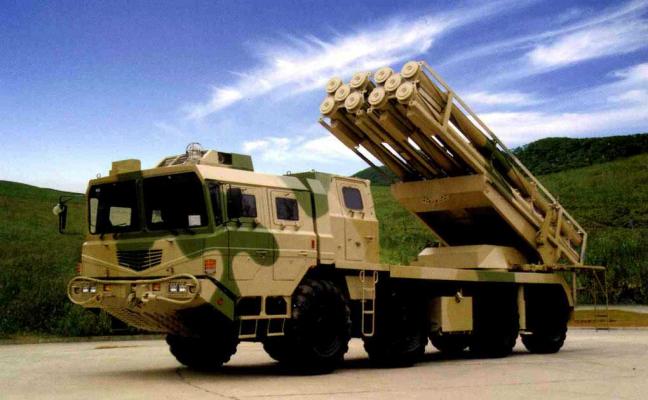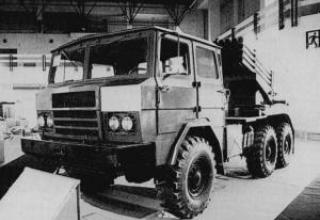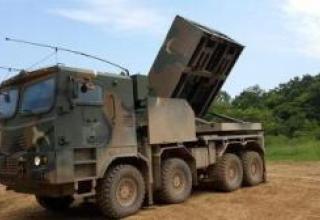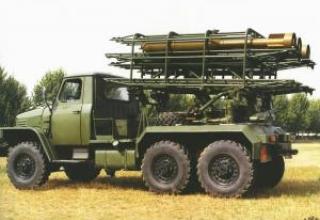AR1A multiple rocket launcher system is designed to suppress or destroy: long-range artillery systems, air defense forces, missile forces, nuclear, biological and chemical protection forces, groups of manpower and armored vehicles of the enemy, helicopters and aircraft on runways, surface ships, command systems, radar stations and centers for wired and wireless (radio) communications, etc. The AR1A system can be used both in offensive and defensive situations.
The AR1A system is a further development of the A-100 system and the Russian Smerch system. FSUE Splav (Tula) took part in the development of the rocket projectile for this Chinese system.
A prototype of the AR1A combat vehicle was first demonstrated by Chinese foreign trade corporation NORINCO at IDEX-2009 (Abu Dhabi, United Arab Emirates).
Composition:
Composition of RESO AR1A:
- The fire support system:
- Combat vehicle (BM) (see side view, in hiking position);
- 300 mm calibre corrective rockets (see photo);
- Transport and Charging Vehicle (TZM).
- Command system:
- Support facilities:
- maintenance machine for technical equipment;
- electronic equipment maintenance machine.
The AR1A can be used as a division or as a battery, as the main fire unit. The system's combat vehicle can be used autonomously. The use of an advanced meteorological system, command and control system, support system allows for an effective fire raid to neutralize various ground targets.
The artillery unit of the BM consists of two transport and launch containers equipped with 300 mm caliber corrective rockets. The presented prototype LM is equipped with the equipment, with the help of which the works on independent determination of the firing position coordinates and direction, automated reception of target data and meteorological messages, automated calculation of firing data, automated pointing and firing are carried out. The rapid deployment of the entire system is ensured through the use of a road network.
Based on the analysis of the available information, it can be concluded that for the PHL03 combat vehicle, BM AR1A prototype and marine installation prototype, the same type of rails are used with the ability to launch 300 mm rounds.
For firing, the 300 mm caliber Corrected Jet Projectiles (CAR) with a maximum range of up to 130 km are used. Several versions of the cattle with different types of combat equipment are developed. All missiles have a universal control unit with angular stabilization and range correction systems.
KRS BRE2. The flight range is from 60 to 130 km. The head part is blasted with ready striking elements. Weight of the head unit is 190 (180)kg. Effective radius of defeat - 100m.
КRS BRE3. The flight range is from 20 to 70 km. The head unit is a cassette unit with 623 cumulative shrapnel fighting elements (CSBE). The CSBE dispersion radius is 80-160m, the depth of armour penetration by cumulative jet is 50mm.
Кrs BRE4. The flight range is from 60 to 130 km. Head part - cassette. The number of equipped KOBE - 480 pcs. The dispersion radius of KOBE from one head unit is 80-160m. Depth of armour penetration by cumulative jet 50mm.
Characteristics:
| Number of guides, pcs. | 10 |
| Caliber,mm | 300 |
| Weight of combat vehicle, kg | 42500 |
| Shooting preparation time, mines. | 5 |
| Camping time, min. | 1 |
| Full salvo time, s | 60 |
| Reaction time in the divisional link, s | 20 |
| Reaction Time in the Battery Link, s | 15 |
| Operational altitude (above sea level), m | up to 3000 |
| Operating temperature range, ° C | -20 – +55 |
| Maximum speed on paved roads, km/h. | 60 |
| Maximum power reserve, km | 650 |
| Guidance accuracy | 1 thousandth (0.05625°) |
| Calculation, man. | 4 |
Testing:
Despite the declared high effectiveness of HARM missiles of early modifications can not be considered a modern high-precision weapon because they do not have a full-fledged recognition system "insider". Thus, for example, during Operation Desert Storm, the U.S. Air Force could not always effectively use HARM missiles because the Iraqi air defense facilities, along with Soviet-made systems (against which the use of this type of missiles is calculated) included American Hawk systems.
Sources:
- Гуров С.В. Реактивные системы залпового огня. Обзор. Изд.2, Электронный вариант, DVD-disk, Дата внесения последних изменений 12.12.2009 г. – ФГУП “ГНПП “Сплав”, Тула. 2009 г. – С. 558, 564-566.
- Информационный сборник "Военно-техническое сотрудничество" - №8(650) - 23-февраля-1 марта 2009. - С.72.











